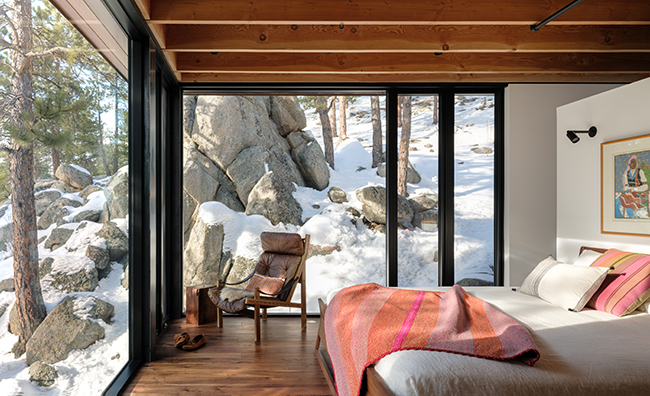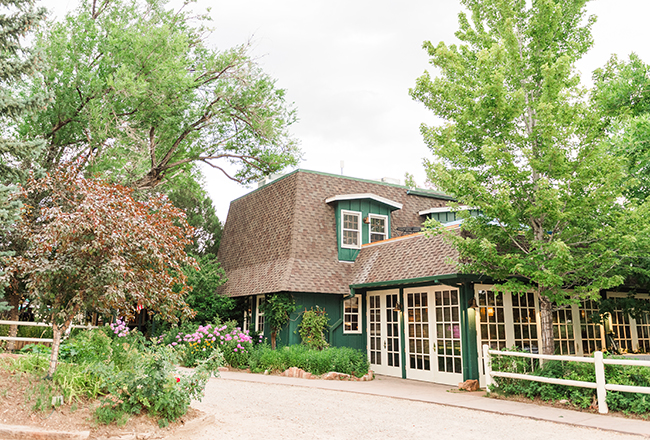Beyond the Chairlift
05 Feb 2024
Take a leap into untouched powder with this premium backcountry pass
By Dell Bleekman
All photos courtesy of Telluride Helitrax, with individual shots by Jeff Cricco and Kane Scheidegger. A-Lodge photos are credited to Kris Klauber.
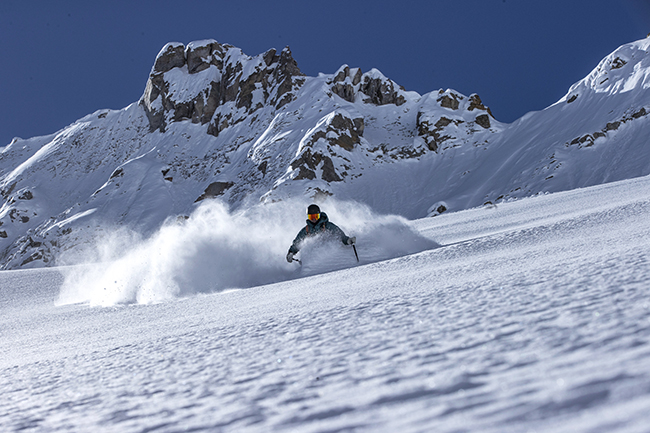
Photo Jeff Cricco and Telluride Helitrax
Maybe it’s the cost of season passes or, heaven forbid, a one-day ticket. Or perhaps it’s the inevitable I-70 backup at Floyd Hill, no matter the alpine start. Nevertheless, more Front Range winter enthusiasts are hanging up their alpine skis and heading into the backcountry.
Sure, backcountry skiing is more work (that whole uphill movement thing). But it’s also more adventurous, offers the chance of untouched powder and is sure to get your adrenaline—and heart—pumping.
Though the allure of untouched powder is undeniable, ensuring a great day and a safe return hinges on having a well-defined destination, cultivating backcountry awareness and equipping oneself with the necessary tools.
Backcountry 101
Many backcountry skiers crave the solitude of escaping crowded slopes and relish the freedom to navigate the mountains on their own terms. To achieve this, these enthusiasts employ a technique known as “skinning,” defying gravity with the aid of specialized skins affixed to their ski bottoms. These skins, comprised of sticky fabric strips, provide the necessary grip on the snow, enabling an ascent against the natural pull.
When it’s time to descend, skiers seamlessly transition from the “free heel” mode—allowing unrestricted uphill movement—by removing the skins and securing their bindings into a locked position. This adjustment ensures a stable platform for the exhilarating descent, allowing for precise and controlled carving down the mountain.
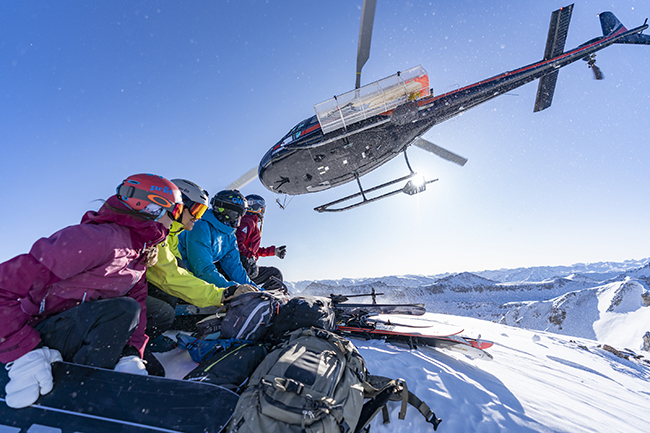
Photo Kane Scheidegger and Telluride Helitrax
Allure of Huts
For some backcountry skiers, the destination itself becomes the focal point, and this is where the allure of hut trips truly shines.
Chris Keenan, a family physician based in Longmont, relishes his annual hut trips. “They’re a great way for me to reconnect with nature in a way that’s a little bit intimidating and keeps me in awe,” he says.
While Keenan was an avid skier during his upbringing, the demands of life—medical school, raising kids and work—gradually shifted his outdoor pursuits towards trail hikes and sporadic 14ers. It wasn’t until seven years ago that an enticing opportunity to journey to a backcountry hut alongside fellow doctors and professionals reignited his passion for connecting with the great outdoors. Since then, each year brings the group to a new destination hut, where they indulge in a long weekend filled with skiing, culinary adventures, and engaging conversations.
This past January, Keenan and the group skinned to Francie’s Cabin, a seven-room hut at 11,300 feet, just southwest of Breckenridge. Inside, solar panels provided light, melted snow became fresh drinking water and a wood stove kept the space cozy and warm.
“There are so many elements of a hut trip I appreciate—the solitude of nature, the work required to get there, and of course the communal aspect,” Keenan says. A nightly highlight at the hut involves a group dinner, with participants bringing up carefully packed food and beverages in their backpacks. “Having paella (a Spanish seafood dish) in the middle of Colorado’s Tenmile Range really stands out,” he says.
Of course, skiers ultimately trek to these destinations for the uncharted skiing. Keenan and his companions leverage the hut as their base camp, setting out in pursuit of pristine, untouched snow. The adventure is a harmonious blend of excitement and seriousness. “This is a group that’s been going on hut trips for more than two decades,” Keenan relays. “They are grounded individuals who aren’t out to prove anything.”
Each skier carries a topographical map, beacon (an emergency locator that helps find someone buried under snow), shovel and avalanche probe (a metal rod used to probe through avalanche debris). “I hope it’s never necessary, and we avoid situations where a slab could cover any of us,” he says. But bringing this type of gear, and knowing how to use it, is an integral aspect of preparing for backcountry skiing.
Going First Class
Then, there are those skiers who seek the backcountry experience and are prepared to invest in a premium adventure in pursuit of untouched terrain. Their pursuit is not merely about skiing through pristine powder; instead, they opt for a different approach, eschewing chairlifts in favor of helicopters. Heli-skiing emerges as a distinct form of backcountry skiing, employing helicopters to reach remote and secluded areas, where untracked powder awaits eager skiers.
Matt Steen assumes the role of Snow Safety Director at Telluride Helitrax, a company offering clients access to over 200 square miles of terrain nestled in the San Juan Mountains around Telluride. Unquestionably qualified for the position, Steen boasts a decade of experience with Helitrax. Prior to this, his extensive background includes roles as an avalanche forecaster with the Colorado Avalanche Information Center (CAIC) and a ski patroller for both Telluride and Crested Butte.
Steen draws on this wealth of experience to provide clients with a safe and unforgettable day in the mountains. “We provide our guests with powder skis, avalanche airbag packs, a beacon, a shovel and a probe,” he says, noting that guests are briefed on how to use these tools and operate around a helicopter. “We talk about avalanche scenarios, how to use beacons and how to search for somebody.” Helitrax also conducts its own avalanche testing in the San Juans. “We’re lucky to have our own explosive mitigation program, providing us the tools to test the stability of a slope,” Steen says.
The expertise, sound judgment and reverence for the terrain that Steen and his colleagues at Helitrax exhibit are unmistakable when guiding clients into the backcountry. Offering advice to newcomers, Steen emphasizes, “I would highly encourage prospective backcountry skiers to know what they’re getting into, as snow is a dynamic medium and there are hazardous areas out there.”
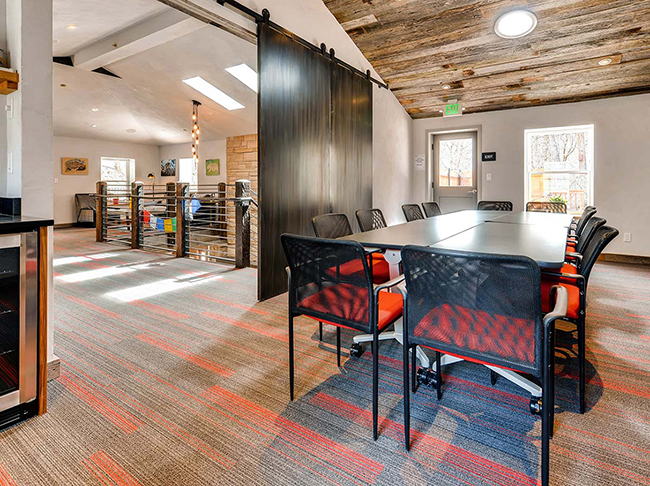
Photo Kris Klauber
Local Lodging
No doubt, Colorado remains a destination for skiers of all types and abilities. For 2023, the trade group Colorado Ski Country reported nearly 14 million skier visits to the Centennial State—and some of those visitors undoubtedly stayed at Boulder’s A-Lodge, a hotel located in Boulder Canyon that caters to outdoor enthusiasts. With 29 rooms, a youth hostel with 12 beds, four campsites and three van-life spaces, the lodge is well equipped to accommodate adventure seekers after a full day spent outdoors.
A-Lodge co-owner Kris Klauber, with deep ties to Boulder dating back to his University of Colorado undergraduate years and tenure as Mountain Sun’s general manager, expresses the uniqueness of the lodge, stating, “There’s not many places where you’re up in the woods, right in the canyon.” An enthusiastic backcountry and alpine skier, as well as a fervent mountain biker, Klauber instills a culture of sharing local knowledge among his staff. He emphasizes, “Anyone can Google ‘backcountry skiing near Boulder’ but having personal anecdotes from an experienced outdoor local is really powerful.”
Klauber still finds time to get out, preferring a day in the backcountry versus an I-70 resort. “Getting to Rocky Mountain National Park is pretty easy from north Boulder, or even just up to Allenspark or Geneva Basin,” he says.
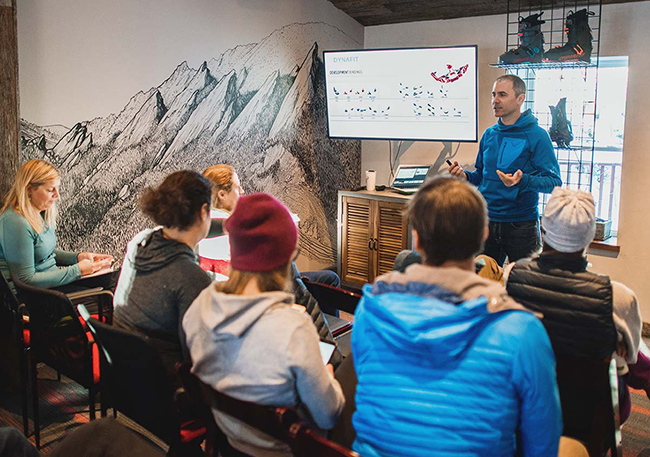
Photo Kris Klauber
Klauber reflects on the Type 2 aspect of backcountry skiing, a dynamic that encapsulates both the elation and the challenges inherent in the experience. “That time when it’s done and you’re having a parking-lot beer is really rewarding,” he says. It’s exactly that type of experience Klauber wants for his guests—to be outdoors and return to the lodge with a story. “Whether it’s providing skiers with a gathering place in the winter with our lobby fireplace or hikers in the summertime with our firepit and beer garden, we love getting like-minded travelers together to share in their experiences and their passions,” Klauber says.
10th Mountain Division Huts is a non-profit organization that manages 38 backcountry huts sprinkled throughout the Colorado Rocky Mountains. The huts allow backcountry skiers to get deep in the mountains and search for that elusive powder stash. For more information on 10th Mountain Division Huts, check out huts.org. For more information on backcountry heli-skiing in the San Juan Mountains, visit helitrax.com. To learn about Boulder’s A-Lodge go to a-lodge.com.
Backcountry Safety
In the pursuit of knowledge and safety, numerous resources are available, with the Colorado Avalanche Information Center (CAIC) standing out as one of
the best.
• Prioritize your safety by enrolling in an avalanche safety course and connecting with experienced individuals who share your passion.
• When preparing for your adventure, opt for local shops and invest the time in a meticulous boot fitting.
• Enhance your navigational skills by learning how to read maps, especially in areas with unreliable cell service.
• Familiarize yourself with your gear well before embarking on your journey, and in the midst of all preparations, don’t overlook the importance of sunscreen for your outdoor escapades.
For up-to-date avalanche information and forecasting for Colorado’s mountains, visit avalanche.state.co.us

